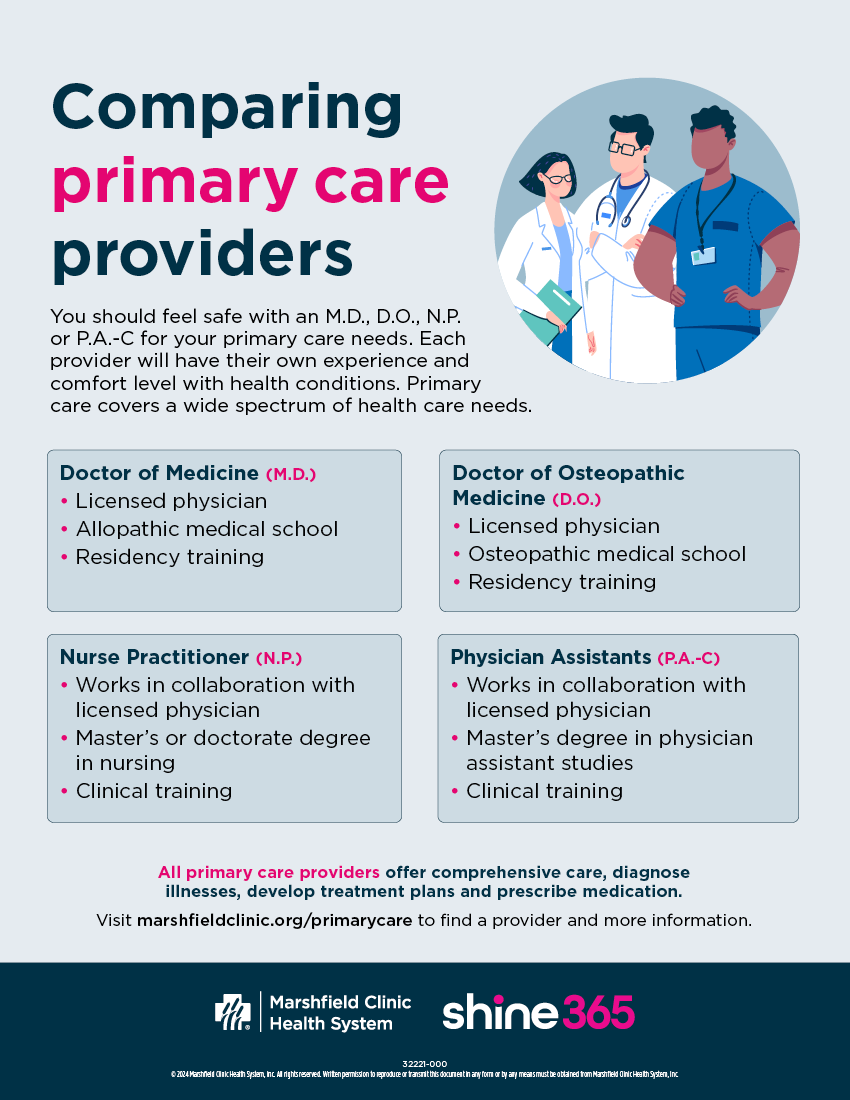When choosing a primary care provider, understanding the difference between MD, DO, NP and PA-C primary care providers can be confusing. You may have specific wants and needs because of your health condition, so you may not know where to start. Because you connect with your primary care provider regularly, you want someone you trust for a lifetime.

Most patients look for a primary care provider who is close to home or easily available. In an article by Journal of Patient Experience, Choosing a Provider: What Factors Matter Most to Consumers and Patients?, “participants most often identified medical license, certification and whether the provider accepts the patients’ health insurance as important.”
Comparing primary care providers
Primary care providers can pursue specific specialties like family medicine or internal medicine.
RELATED ARTICLE: What is a primary care provider?
Additionally, your provider may have different credentials, such as M.D., D.O., N.P. and P.A.-C after their name, which describes the education and training they completed.
Common credentials include:
- M.D. – Doctor of Medicine
- D.O. – Doctor of Osteopathic Medicine
- N.P. – Nurse Practitioner
- P.A. – Physician Assistant
Another credential of physicians is a Bachelor of Medicine, Bachelor of Surgery (MBBS). MBBS is an acronym that commonly depicts an international medical graduate’s training. This is equivalent to a M.D. in the United States.
Here is a chart comparing the common credentials of a primary care provider:
Download this comparing primary care provider handout

In general, you should feel safe with any credential for your primary care needs. Each provider will have their own experience and comfort level with health conditions. Primary Care covers a wide spectrum of health care needs.
“It’s about building a relationship with your provider that feels like a partnership,” said Dr. Jennifer Strong, family medicine physician with Marshfield Clinic Health System. “The provider will make recommendations, based on their medical knowledge, and then it’s up to the patient to respond to those recommendations”.
Having trust and connection with your health care provider is essential. You can always ask for a second opinion or get referred to another provider if someone does not fit your needs.
Allopathic medicine and osteopathic medicine
The main difference between a M.D. and D.O. is the type of medical school.
A doctor with an M.D. attends an allopathic medical school, which focuses on treating a specific disease. Allopathy, often referred as Western, conventional medicine, treats disease with remedies like surgery or medication, and some providers also use a comprehensive approach to care. This means they will get to know your lifestyle, family and more to solve your health concerns.
Osteopathic medicine views patients holistically to reach a diagnosis rather than treating symptoms alone. A doctor with a D.O. treats patients with medication, surgery and supportive care in the same way as MDs, but in some circumstances, will offer additional hands-on therapy (osteopathic manipulation) of the body’s tissues and bones to help with the healing process.
Nurse Practitioner and Physician Assistant
Primary care providers who do not attend medical school are called a Nurse Practitioner (N.P.) or Physician Assistant, Certified (P.A.-C).
An N.P. is a nurse who has advanced clinical education and training. NPs perform the same procedures as doctors like physical exams, diagnosis and treatment of diseases and other health conditions, and prescribe medications.
A P.A.-C is a health care professional trained to diagnose and treat illness as well as provide preventive care under physician supervision. A significant difference between a PA-C and a MD or DO is the amount of training required of each.
PAs finish their training in about two years, while physicians finish medical school in around four years. After the four years, physicians must go through internships and residencies, which PAs do not have to complete.
Doctors vs. residents
Some health systems like Marshfield Clinic Health System have residents who are training and shadowing doctors in Primary Care. Residents have recently graduated from medical school and are completing their post-graduate training.
Therefore, residents are M.D. or D.O. providers who are training to complete their specific training to become a physician. In a hospital or clinic setting, a resident can care for you, but you may have a physician supervising.
If you select a resident as your main primary care provider, they may choose a new location to start their medical career after residency. However, residents can continue to care for you at the same location after they completed their residency.
Choose a provider right for you
Whether you want someone with specific credentials or need someone nearby, Marshfield Clinic Health System has primary care locations throughout Wisconsin and beyond to care for you. Visit the Primary Care page to find a provider who meets your needs.
Schedule an appointment with a Marshfield Clinic Health System primary care provider.
Schedule appointment Learn more about Primary Care
Related Shine365 articles
What is a primary care provider?
Wellness checkup: A physical examination by your family doctor






Leave a Reply